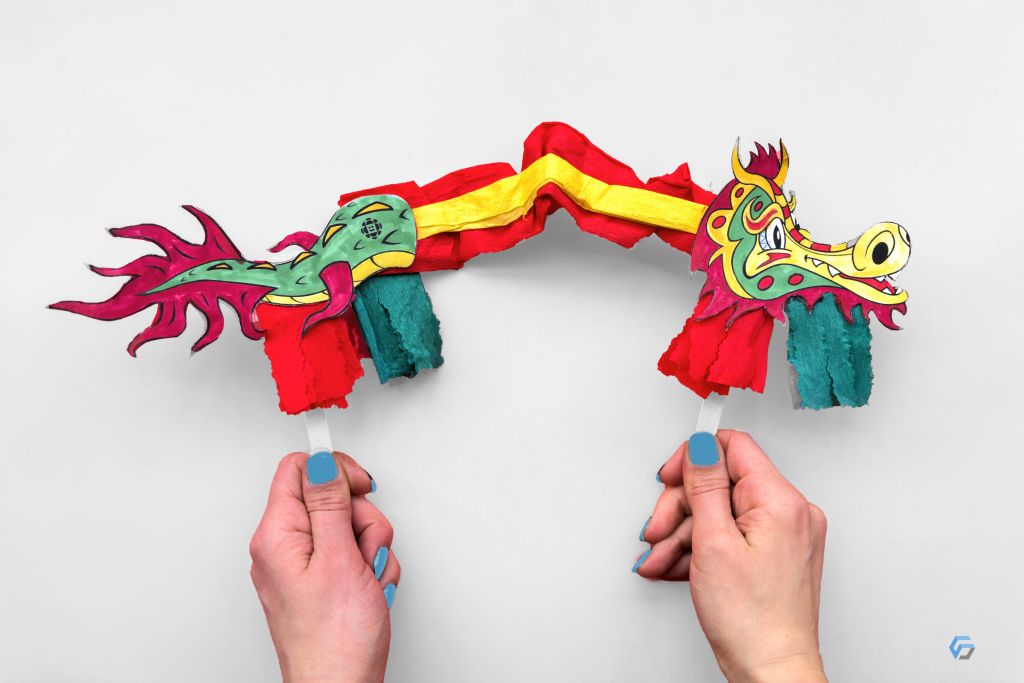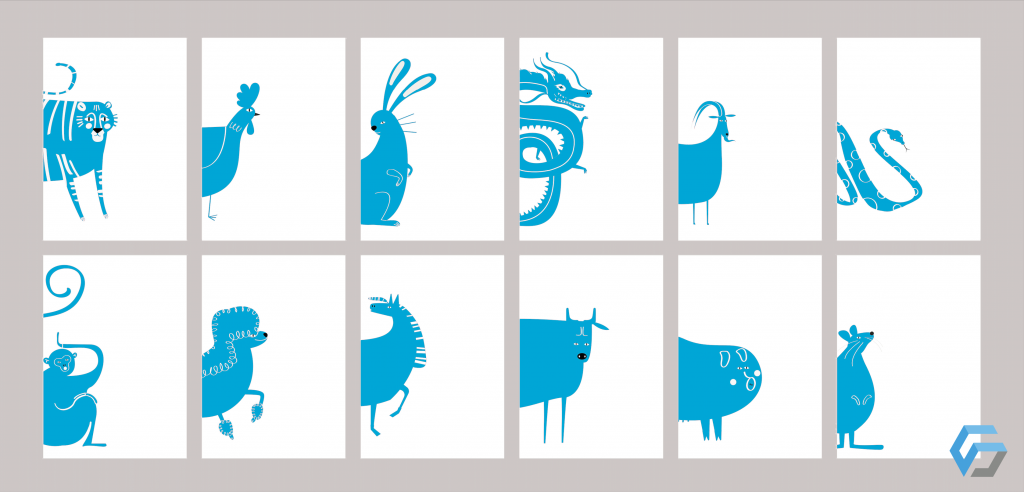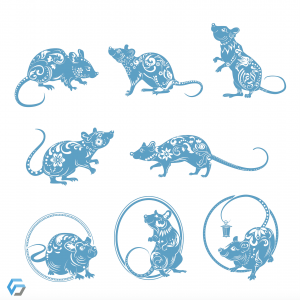[:it]
When does Chinese New Year 2020 occur?
Symbols and traditions of the Chinese New Year
The traditional parade (“dance”) of the dragon, made of paper mache and cloth in the streets is the central element of ceremonies related to New Year. Hailed and depicted in so many films, it is a celebration that lives on mostly in the tradition of rural villages and for Chinese communities abroad, while it has less prominence in China’s large metropolises. The dragon is one of the pivotal symbols in Chinese culture and represents good luck and prosperity for the New Year.

Dragon dance done with hands
The Chinese Zodiac

All in Chinese zodiac signs
What is eaten during the Chinese New Year?
Isn’t good food the essential component of the holidays? So let’s find out what are the main dishes that are eaten during these days of joy and celebration. During the lavish celebratory banquets on Chinese tables certain foods abound that are thought to be auspicious for the New Year:
- Oranges and tangerines symbolize good fortune and are often given to friends and relatives during a visit as a sign of gratitude and respect.
- The fish, in Chinese“Yú,” has similar phonetics to the word meaning and recalls “abundance“
- Pineapple meaning “prosperity” in Chinese, the streets in fact are decorated with pineapple-shaped lanterns and they are eaten as a festivity especially on the first of the year.
- Longevity noodles: an ancient Chinese belief has it that the long noodles called “ramen” are an omen for a long and prosperous life, so they should never be cut while eating them. Also traditionally, the more noise one makes while eating them, because they are sucked up by the broth in which they are served, the more it means they are liked.
- Chinese dumplings“Jiaozia “, given their shape similar to gold bars are said to bring wealth and it is believed that the more dumplings you eat on New Year’s Eve, the more money you will earn in the year to come. In some parts of China, a string or coin is hidden in the dough and whoever finds it will be lucky.

Women’s hands serving good food on the table during Chinese New Year 2020
The most peculiar customs of the Chinese New Year
The more traditionalist Chinese follow during the New Year celebrations, several thousand-year-old traditions for example the custom of giving money in red envelopes and the most absolute prohibition of wearing black on the first day of the year because it is a color that recalls death and bad luck.
In the days leading up to New Year, every Chinese family also engages in spring cleaning to get rid of undesirable things, including dust and evil spirits to make room for New Year’s gifts. But sweeping the floor during New Year celebrations is believed to ward off good luck! Finally, it seems common custom that children should stay up late on New Year’s Eve to “keep the years” for their parents. In fact, the later they go to sleep, the longer their parents’ lives will be.
Tekube wishes you Happy Chinese New Year 2020 and a prosperous year of the mouse!

Graphic depictions of the year of the mouse
[:en]In China and in China Towns around the world, the Chinese New Year 2020 will soon be celebrated. Also known as the Spring Festival, it has a millennial history.
The Chinese New Year is a very important event in the East, but it is not very well known in our country, so we decided to tell you some interesting facts about when, where, how and why Chinese New Year is celebrated.
When does the Chinese New Year 2020 occur?
According to this Chinese solar calendar, in which the months begin with the new moon, the New Year’s date can vary by around 29 days, coming to coincide with the second new moon after the winter solstice, an event that can fall between January 21 and February 19 of the Gregorian calendar. This year the first day of the Chinese year falls on January 25th.
Legend has it that Emperor Huang Ti introduced this festival in 2637 BC, although no one can say with certainty when this party began. What is certain is that the Chinese New Year is an integral part of Chinese culture and all subsequent holiday dates are calculated based on this astronomical date.
Symbols and traditions of the Chinese New Year
The traditional parade (“dance”) of the dragon, of papier-mache and cloth in the streets is the central element of the ceremonies connected to the New Year. Acclaimed and represented in many films, it is a celebration that lives mainly in the tradition of rural villages and for Chinese communities abroad, while it has less prominence in the great Chinese cities. The dragon is one of the key symbols in Chinese culture and represents good luck and prosperity for the new year.

Handcraft dragon of paper
Other symbols of the Chinese New Year include plum blossoms, which represent courage and hope and the aquatic narcissus, considered an “auspicious flower.” The “Good Luck” wishes written in Chinese ideograms on red paper and the “lucky mandarins” are also very widespread in this period.
Chinese Zodiac
According to a popular legend, the Jade Emperor, Lord of Heaven and Earth, called for a competition to assign the names of the top 12 to the same number of sections of the traditional Chinese calendar. It is said that the cunning mouse deceived the cat (from which their proverbial enmity was born) to get there first; the dragon that was the favorite arrived only fifth because, given his benevolence, he lost time helping the people of a village and that the dog and the pig arrived last because they took it easy to wallow in the river and to crush some naps along the way.
So in order, the 12 animals of the Chinese zodiac are mouse, ox, tiger, rabbit, dragon, snake, horse, goat, monkey, rooster, dog and pig.
January 25, 2020 will be the year of mouse that greets the previous year of the pig, if you were born in the years 1996, 1984, 1972, 1960, 1948 you are of this sign. Who was born under the sign of the mouse, according to Chinese culture, he is sharp, versatile, kind and resourceful.
WHICH SIGN ARE YOU?

Chinese Zodiac Signs
Discover your Chinese zodiac sign and its meaning here.
What do you eat during the Chinese New Year?
Isn’t good food the essential component of the holidays? So let’s find out what are the main dishes that are consumed during these days of joy and celebration. During the sumptuous celebratory banquets on the Chinese tables abound some foods that are thought to be a good omen for the new year:
- Oranges and mandarins that symbolize good luck and are often given as gifts to friends and relatives during a visit as a sign of gratitude and respect.
- The fish, in Chinese “Yú,” has a phonetics similar to the word that means and recalls “abundance”
- Pineapple which means “prosperity” in Chinese, the streets are in fact decorated with pineapple-shaped lanterns and are eaten as a special occasion, especially the first of the year.
- Spaghetti of longevity: an ancient Chinese belief tells that long noodles called “ramen” are auspicious for long and prosperous life, so they should never be cut while eating. By tradition, moreover, the more noise is made by eating them, because they are sucked into the broth in which they are served, and more it means that they are welcome.
- The Chinese ravioli “Jiao aunt,” given their similar shape as gold bars is said to bring wealth and it is believed that the more ravioli you eat at New Year’s Eve, the more money you will earn in the coming year. In some areas of China, a thread or a coin is hidden in the dough and whoever finds it will be lucky.

A woman serving food for the Chinese New Year
The most particular customs of Chinese New Year
The most traditional Chinese follow during the New Year celebrations, several thousand-year-old traditions such as the use of giving money in red envelopes and the absolute prohibition of wearing black on the first day of the year because it is a color that recalls death and misfortune.
In the days leading up to the New Year, every Chinese family also engages in spring cleaning to get rid of undesirable things, including dust and evil spirits to make room for the gifts of the new year. But it is believed that sweeping the floor during the New Year celebrations ward off luck! Finally, it seems common practice for children to stay up late on the eve of the new year to“keep the years” for their parents. In fact, the later they go to sleep, the longer their parents’ lives will be.
Tekube wishes you a Happy Chinese New Year 2020 and a prosperous year of mouse!

Chinese New Year 2020, Year of mouse
And with this occasion, we remind you that our production partners will also take part in the party and will suspend production for about 2 weeks, from January 18 to February 2 inclusive. The last week to confirm orders with shipping before Chinese New Year 2020 is, therefore, the No. 50, between December 9 and 13.
For orders relating to fast productions and samples, the deadline is Friday, January 10, 2020.
It is therefore advisable to book in advance your productions that will have to arrive in Italy in January and February 2020: Tekube recommends that you confirm the productions in the first half of December 2019 to avoid any delays.
If you haven’t already done so, contact us immediately at info@tekube.com
不久
[:]











